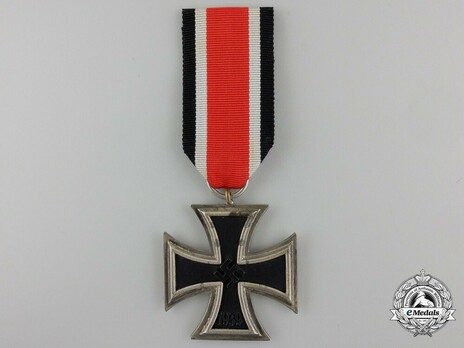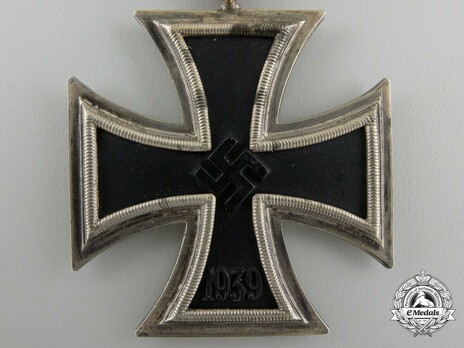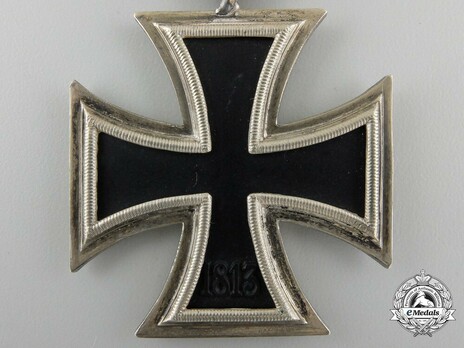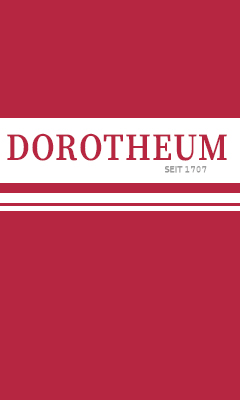Iron Cross II Class, by C. E. Juncker, #2, L/12
SKU: 01.GTR.0101.111.11
Estimated market value:



Estimated market value:
Attributes
Physical Description
C. E. Juncker was one of the earliest companies to manufacture the II Class Iron Cross. Therefore, there are a multitude of different versions, consisting of several variations of frames and cores.
Juncker, in all likelihood, stopped production of the II Class Iron Cross before late 1942/early 1943, since there are no crosses marked “2”, Juncker’s PKZ number.
Schinkel frame
Early Juncker crosses were made with a so-called “Schinkel” frame, manufactured with a die from the company of A. Werner & Söhne (AWS), which Juncker had used during WWI to produce their 1914 Iron Crosses. Juncker used the same frame on their early I Class Iron Crosses. Initially, II Class Iron Cross cores used in this frame were made of zinc, which was quickly changed to iron.
This Schinkel frame has two visible die flaws in the “knees” of the 6 o’clock arm. It remains unmarked.
The Schinkel core has several recognisable characteristics: the “nose” of the 1 in “1939” is distorted and the ball point of the number 3 reaches higher than those of the two 9s. The lower part of the number 3 of “1813” has a very pronounced curve, nicknamed “cinnamon roll”.
Crunch Bead frame
The “crunch bead” frame is named after a bead of the frame that has either been split into two thin parts, or is actually two thinner than usual beads next to each other. This feature can be found on the lower right side of the 12 o’clock arm, just above the inner corner. Another typical feature of Juncker crosses can be observed, which is the cross-hatching of the beads in the corners where the bead strands meet.
Another way to identify the “crunch bead” frame is by looking for three small bulges on the frame right outside the beads, located at the top left of the 12 o’clock arm, at the bottom of the 6 o’clock arm below the space between the numbers 1 and 8 in “1813” or 1 and 9 in “1939”, and one just below the left “knee” of the 6 o’clock arm. Because of this, the “crunch bead” frame is also known as the “three flaw” frame.
This frame was also used by Juncker on their I Class Iron Crosses.
The “crunch bead” frame was used with multiple different core variants.
One was the above mentioned Schinkel core.
The “W&L” core is named after another medal manufacturer, Wächtler & Lange. It is likely that Juncker supplied Wächter & Lange with this core. The reverse is identical to the one of the Schinkel core. However, the obverse is different, presenting a “1939” date where the numbers 3 and 9 drop a little bit lower than 1 and 9.
The “teardrop” core once more has the same reverse as the Schinkel core. The obverse can be identified by the shape of the inner parts of the two 9s, which are wider at the bottom than the top, giving them a slight teardrop shape. This feature is easier to recognise in the first 9, since the second 9 leans a little bit to the left, somewhat distorting the feature. Similarly to the “W&L” core, the numbers 3 and 9 dip a little lower than the numbers 1 and 9. The “teardrop” core has only been found made of iron.
The combination of “crunch bead” frame with “teardrop” core is known as a “full Juncker”, the classic Juncker cross setup. This can be found unmarked or with Juncker’s LDO number, L/12. Contrary to regulations, Juncker did not stamp the ribbon ring with their LDO number, but rather the frame below and slightly to the right of the loop.
W&L frame
Just as with the “W&L” core, the “W&L” frame was likely produced by Juncker and supplied to Wächtler & Lange. The “W&L” frame has the “crunch bead”, but it lacks the cross-hatching of the beads in the corners that is present on the regular “crunch bead” frame. The frame can be unmarked or marked L/12, in the same way it is done on the “crunch bead” frame.
The “W&L” frame is completed by the above introduced “W&L” core.
This exact cross can also be found made by Wächtler and Lange, either unmarked or marked with the company’s PKZ number, “100”, on the ribbon ring. If unmarked, the question of Wächtler & Lange or Juncker can sometimes be answered based on the cross’s finish. The finish of the beading on a Juncker cross will appear more yellowy compared to a stronger silver-coloured finish on a Wächtler & Lange cross. The frame outside the beads on a Wächtler & Lange cross will also appear more strongly silver-coloured. However, it is important to note that this comparison is tricky, and can only be successfully done, if at all, on very well-preserved crosses.
Common L/12 frame
The “common L/12” frame lacks both the “crunch bead” and the cross-hatching. It does however feature a visible “valley” in each of the two upper corners of the 12 o’clock arm where the two strands of beads meet. The L/12 stamp is found in the same spot as on the “crunch bead” and “W&L” frames, but it can also be missing altogether.
History
The Iron Cross was originally founded in 1813 and was considered Germany’s highest military decoration. On September 1st, 1939, Adolf Hitler renewed the Order of the Iron Cross and instituted the decoration in four grades, II Class Iron Cross, I Class Iron Cross, Knight’s Cross and Grand Cross.
The II Class Iron Cross was conferred upon military personnel who performed a single act of bravery in the face of the enemy or acted in a way that went above and beyond the call of duty. The II Class was the most commonly awarded Iron Cross during the Second World War, and today, it is the most commonly found and the least expensive of the Iron Cross grades.
This grade was suspended from a ribbon and it could be worn in three different ways: attached to the second button of the tunic; mounted alone or as part of a ribbon bar when worn with formal attire; or the ribbon could be worn by itself for everyday wear.
Award numbers are unknown and will likely remain so. Estimates place the numbers at 2.5 million at the lower end and 5.5 million at the higher end, with approximately 3.5 million being the most likely number. Crosses produced are estimated at around 5 to 6 million.
Women, mostly nurses, are known to have been awarded the II Class Iron Cross. However, the numbers are extremely low, and only a few dozen female recipients are known today.
The II Class Iron Cross is generally made of a silvered frame and an iron core painted black. Different materials have been used on occasion and will be covered where applicable.
Individual makers or their cross versions and variants are often distinguished by flaws and irregularities of the frame. Usually, the frame is oriented in a certain way. However, if it is misaligned, flaws can be situated on the “wrong” cross arm. Obverse and reverse of the frame can also be used interchangeably. The reader should keep this in mind when a particular flaw in a particular spot is mentioned.
Frames and cores of several makers share a similar design. This is due to the fact that the company of Steinhauer & Lück (S&L) is known to have manufactured frame and core dies for several smaller companies.
Not every II Class Cross features a maker’s mark, although, if there is one present it will generally be stamped on the ribbon ring. Each firm was allocated a manufacturing number to indicate which decorations they had produced. Firms that were licensed to produce official state awards were issued Lieferant Numbers by the Präsidialkanzlei des Führers, referred to as PKZ numbers. Some firms were licensed to produce private-purchase replacement awards and were issued LDO (Leistungsgemeinschaft Deutscher Ordenshersteller) numbers. LDO pieces were stamped with a maker’s code that had an “L/” prefix, while Präsidialkanzlei items were stamped with numbers without a prefix.
Unmarked crosses were manufactured between the beginning of the war and late 1942 or early 1943. At that time the PKZ requested all crosses to be numbered. LDO marked crosses were first produced in early 1941. However, II Class Iron Crosses with LDO numbers are actually relatively rare.
More than 60 companies are known to have produced the II Class Iron Cross, in varying quantities.
The standard size of the II Class Iron Cross is approximately 44.5 x 44.5mm, although there are versions that are larger and smaller. Along with numerous stickpin miniatures, there is a rare Prinzen sized cross that is around 30.5x33mm. In addition, a larger “Übergröße” (oversize) cross was produced by maker Frank & Reif and is around 47 to 48mm, closer in size to the Knight’s Cross of the Iron Cross. The Übergröße cross has a frame produced out of “900” silver. The original reason for these crosses being produced larger than standard ones is unknown.
There is a slimline variation of the II Class Iron Cross that is known as the “Schinkel-form” or “Schinkel” cross. All Imperial Iron Cross awards were modelled after the 1813 Iron Cross, which was designed by Karl Friedrich Schinkel. When the Iron Cross was reinstated in 1939, some manufacturers used existing dies of 1914-style silver frames leftover from the First World War, resulting in crosses with a smaller center and narrower arms, and smaller, more delicate features. This practice was quickly stopped, as Hitler wanted the new Iron Cross to be larger in size. Examples of the 1939 Schinkel cross produced by various companies have been awarded until early 1940.
Due to the sheer number of different variants, the versions shown for each maker are just an approximation and not a definitive or conclusive list.

Versions
$100 USD
Zinc/Neusilber
Obv: 1939 Rev: 1813
45x45mm
This version features a so-called Schinkel frame and the core is made of zinc.
$100 USD
Iron/Neusilber
Obv: 1939 Rev: 1813
45x45mm
This version features a so-called Schinkel frame and the core is made of iron.
$100 USD
Zinc/Neusilber
Obv: 1939 Rev: 1813
45x45mm
This version features the so-called Crunch Bead frame and the core is made of zinc.
$100 USD
Iron/Neusilber
Obv: 1939 Rev: 1813
45x45mm
This version features the so-called Crunch Bead frame and is unmarked. The core is made of iron.
$100 USD
Iron/Neusilber
Obv: 1939 Rev: 1813
45x45mm
This version features the so-called Crunch Bead frame and is marked with the company's LDO number, "L/12". The core is made of iron.
$100 USD
Iron/Neusilber
Obv: 1939 Rev: 1813
45x45mm
This version features the so-called W&L frame and is unmarked.
$100 USD
Iron/Neusilber
Obv: 1939 Rev: 1813
45x45mm
This version features the so-called W&L frame and is marked with the company's LDO number, "L/12".
$100 USD
Iron/Neusilber
Obv: 1939 Rev: 1813
45x45mm
This version features the so-called Common L/12 frame and is unmarked.
$100 USD
Iron/Neusilber
Obv: 1939 Rev: 1813
45x45mm
This version features the so-called Common L/12 frame and is marked with the company's LDO number, "L/12".


Comments
Sign in to comment and reply.


Scroll Top